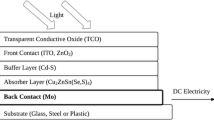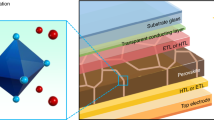Abstract
Purpose
Thin film copper indium gallium (di)selenide (CIGS) photovoltaic (PV) modules show promise for significant growth. The Photovoltaics Manufacturing Consortium (PVMC) is leading research and development of CIGS in New York State. This study presents the results of a life cycle assessment (LCA) study of CIGS technology, currently being advanced by PVMC, and compares the environmental performance of several emerging alternative materials and processes. The results provide manufacturers with an understanding of how to produce CIGS sustainably.
Methods
The cradle-to-gate LCA study followed the International Standards Organization (ISO) 14040 series. In addition to analyzing CIGS cells, the study evaluated zinc oxysulfide (Zn(O,S)) as an alternative for cadmium sulfide (CdS) for the junction partner, and an integrated cell interconnect (ICI) system as an alternative for the screen printing and stringer. Life cycle inventory data for the CIGS cell and alternatives were obtained from PVMC for the product manufacturing stage. Global Solar Energy, Inc. (GSE), a PVMC member and CIGS manufacturer, provided data for the ICI alternative. This data was supplemented by secondary data, from thinkstep, and modeled in GaBi6. The end-of-life stage was not modeled due to limited inventory data.
Results and discussion
The results identified the following key drivers of environmental and toxicity impacts from the manufacture of CIGS photovoltaic cells: (i) silver used in the stringer and screen printing processes, (ii) metals comprising the CIGS layer, (iii) surface washing of the stainless steel substrate, and (iv) copper in the cable for the balance of system. In addition, the study found that the zinc oxysulfide alternative had lower overall impacts compared to cadmium sulfide. Substitution of the ICI system also reduced impacts of the CIGS system, by decreasing the silver needed. Finally, comparison of the overall life cycle impact results to similar systems in literature, which focused primarily on greenhouse gas emissions, found that the CIGS system fell in the lower end of the range of estimated global warming impacts.
Conclusions
PVMC’s CIGS module impacts are likely lower than those made by other manufacturers due to their use of a stainless steel versus glass substrate and reliance on a relatively clean energy mix in New York State. To further reduce impacts, PVMC may wish to substitute the ICI component for the stringer and screen printing processes, recycle additional waste materials, substitute recycled metals for virgin materials, and substitute the cadmium sulfide with the zinc oxysulfide alternative.







Similar content being viewed by others
References
Bekkelund K (2013) A comparative life cycle assessment of PV solar systems. Master Thesis, Norwegian University of Science and Technology, August 2013
Cucchiella F, D’Adamo I (2012) Estimation of the energetic and environmental impacts of a roof-mounted building-integrated photovoltaic systems. Renew Sust Energ Rev 16:5245–5259
de Wild-Scholten M (2013) Energy payback time and carbon footprint of commercial photovoltaic systems. Sol Energy Mater Sol Cells 119:296–305
Dominquez-Ramos A, Held M, Aldaco R, Fischer M, Irabien A (2010) Prospective CO2 emissions from energy supplying systems: photovoltaic systems and conventional grid within Spanish frame conditions. Int J Life Cycle Asses 15:557–566
Einsenberg DA, Yu M, Lam CW, Ogunseitan OA, Schoenung JM (2013) Comparative alternative materials assessment to screen toxicity hazards in the life cycle of CIGS thin film photovoltaics. J Hazard Mater 260:534–542
Frankl P, Corrado A, Lombardelli S (2004) Photovoltaic (PV) systems: final report. Ambiente Italia, Rome
Frischknecht R, Heath G, Raugei M, Sinha P, de Wild-Scholten M et al. (2016) Methodology guidelines on life cycle assessment of photovoltaic electricity, 3rd edition. International Energy Agency (IEA) PVPS Task 12, Report T12–08:2016. Available at http://www.iea-pvps.org
Fthenakis V (2009) Sustainability of photovoltaics: the case for thin-film solar cells. Renew Sust Energ Rev 13:2746–2750
Fthenakis V, Frischknecht R, Raugei M, Kim H, Alsema E, Held M, de Wild-Scholten M (2011a) Methodology guidelines on life cycle assessment of photovoltaic electricity, 2nd edition. International Energy Agency Photovoltaic Power Systems Programme. Report T12–03:2011
Fthenakis V, Kim HC, Frischknecht R, Raugei M, Sinha P, Stucki M (2011b) Life cycle inventories and life cycle assessment of photovoltaic systems, International energy Agency (IEA) PVPS task 12. Report T12-02:2011
Google (2015) Google Maps. Accessed April, 2015 via https://www.google.com/maps
Ito M, Kato K, Komoto K, Kichimi T, Kurokawa K (2008) A comparative study on cost and life-cycle analysis for 100 MW very large-scale PV (VLS-PV) systems in deserts using m-Si, a-Si, CdTe, and CIS modules. Prog Photovolt Res Appl 16(1):17–30
Ito M, Komoto K, Kurokawa K (2009) A comparative LCA study on potential of very-large scale PV systems in Gobi desert. Presented at the 34th IEEE Photovoltaic Specialists Conference (PVSC), 7–12 June 2009, Philadelphia, PA, USA
Ito M, Komoto K, Kurokawa K (2010) Life-cycle analyses of very-large scale PV systems using six types of PV modules. Curr Appl Phys 10:S271–S273
Jungbluth N, Stucki M, Flury K, Frischknecht R, Busser S (2012) Life cycle inventories of photovoltaics. ESU-services and Swiss Federal Office of Energy. Version 174-LCI-Photovoltaics-2012_v1.1, 05/09/2012 11.23.00
Kim HC, Fthenakis V, Choi J, Turney DE (2012) Life cycle greenhouse gas emissions of thin-film photovoltaic electricity generation; systematic review and harmonization. J Ind Ecol 16, Number S1
Leccisi E, Raugei M, Fthenakis V (2016) The energy and environmental performance of ground-mounted photovoltaic systems—a timely update. Energies 9(8):622
Marwede M, Berger W, Schlummer M, Maurer A, Reller A (2013) Recycling paths for thin-film chalcogenide photovoltaic waste—current feasible processes. Renew Energ 55:220–229
McDonald NC, Pearce JM (2010) Producer responsibility and recycling solar photovoltaic modules. Energy Policy 38:7041–7047
North American Clean Energy (2015) “Flagship Catalina Solar Project—Part of a greater hybrid renewable story,” 13 Jul 2015 (http://www.nacleanenergy.com/articles/20662/flagship-catalina-solar-project-part-of-a-greater-hybrid-renewable-story)
NREL (National Renewable Energy Lab (2013) Life cycle greenhouse gas emissions from electricity generation. NREL/FS-6A20–57187, January 2013
NREL (National Renewable Energy Lab) (2017) Best research-cell efficiencies. Accessed April, 2017 via https://www.nrel.gov/pv/assets/images/efficiency-chart.png.
Nuss P, Eckelman J (2014) Life cycle assessment of metals: a scientific synthesis. PLoS One 9(7):e101298
Nuss P, Eckelman J (2015) CIGS impact assessment using economic allocation and TRACI 2.1, TRACILCIA_Cu_Ga_In_Se.xls. Received by email, May 15th, 2015
Paetel S (2016) Roadmap CIGS towards 25% efficiency. 7th International Workshop on CIGS Solar Cell Technology. June 23rd, 2016, Munich. Available at https://www.photovoltaic-conference.com/images/2016/2_Programme/parallel_events/7thInternationalWorkshopCIGS/Stefan_PAETEL.pdf
Peng J, Lu L, Yang H (2013) Review on life cycle assessment of energy payback and greenhouse gas emission of solar photovoltaic systems. Renew Sust Energ Rev 19:255–274
PVMC (2014) U.S. Photovoltaic Manufacturing Consortium website. Accessed on June 4, 2015 via http://www.uspvmc.org/about_PVMC_logicalPartnership.html and http://www.uspvmc.org/mission_PVMC.html
PVMC (2017) Email communications with U.S. Photovoltaic Manufacturing Consortium. Received 2014–2017
Raugei M, Bargigli S, Ulgiati S (2007) Life cycle assessment and energy pay-back time of advanced photovoltaic modules: CdTe and CIS compared to poly-Si. Energy 32:1310–1318
Ryberg M, Vieira MDM, Zgola M, Bare J, Rosenbaum R (2013) Updated U.S. and Canadian normalization factors for TRACI 2.1, Clean Technology Environmental Policy, May 20, 2013
SeaRates.com. (2015) Distances and time tool. Accessed April, 2015 via http://www.searates.com/reference/portdistance/
SENSE (Sustainability Evaluation of Solar Energy Systems) (2008) LCA analysis. Funded by the European Community under the 5th Framework Programme. Revised Version 06/2008
Solarbuzz (2014) PV Equipment Quarterly 2014. Figure 1: 2014 Solar PV Module Production by Technology
Solar Frontier (2014) Light soaking effect: highest yields—and how you reap added benefits. Accessed June, 2015 via http://www.solar-frontier.eu/en/cis-technology/light-soaking-effect/
Thinkstep (2015). GaBi Software (Version 6). Leinfelden-Echterdingen, Germany. Available at http://www.gabi-software.com/
U.S. EPA (1998) Arsenic, inorganic Quickview (CASRN 7440–38-2). Integrated Risk Information System (IRIS). Accessed June, 2015 via http://cfpub.epa.gov/ncea/iris/index.cfm?fuseaction=iris.showQuickView&substance_nmbr=0278#carc
U.S. EPA (1995) Mercury, elemental (CASRN 7439-97-6). Integrated Risk Information System (IRIS). Accessed June, 2015 via http://www.epa.gov/iris/subst/0370.htm
U.S. EPA (2004) Lead and compounds (inorganic) (CASRN 7439-92-1). Integrated Risk Information System (IRIS). Accessed June, 2015 via http://www.epa.gov/iris/subst/0277.htm
U.S. EPA (2011) Ecological toxicity information—copper. Region 5 Superfund. Accessed June, 2015 via http://www.epa.gov/R5Super/ecology/toxprofiles.htm#cu
U.S. EPA (2014) Copper mining and production wastes. Radiation Protection. Accessed June, 2015 via http://www.epa.gov/radiation/tenorm/copper.html
U.S. EPA (2012). Emissions and Generation Resource Integrated Database 2012 (eGRID2012). Accessed April, 2015 via http://www.epa.gov/cleanenergy/energy-resources/egrid/
USETox (2010) User manual. Retrieved April, 2015 from http://www.usetox.org/sites/default/files/support-tutorials/user_manual_usetox.pdf
U.S. Geological Survey (USGS) (2015) Minerals yearbook Volume I. Metals and minerals. Accessed April, 2015 via http://minerals.usgs.gov/minerals/pubs/commodity/myb/
Acknowledgements
Shanika Amarakoon and Cyril Vallet of Abt Associates, Inc., Dr. Mary Ann Curran, and PVMC supported this life cycle assessment (LCA) under contract to the New York State Energy and Research Development Authority (NYSERDA). The authors gratefully acknowledge the outstanding contributions of the following individuals for their assistance in providing technical support, data, and guidance that was important for the successful completion of the report:
• Urs Schoop and Kyle Justice of Global Solar Energy (GSE) for providing data on the ICI system alternative;
• Judy Jarnefeld and Sandy Meier, the NYSERDA Project Managers, for providing technical review and guidance; and
• Dr. Phillip Nuss of Yale University and Dr. Mathew Eckelman of Northeastern University. Their assistance in providing impact results several metals based on the economic allocation method described in their study was greatly appreciated.
The authors would also like to acknowledge the contributions of the Abt Associates staff who assisted the authors, including the following: Jonathan Dorn and David Cooley provided research and support related to the NY State grid mix based on their support of eGRID data for EPA. In addition, Lauren Brown provided review and guidance related to toxicity impacts for several materials in the CIGS system.
Author information
Authors and Affiliations
Corresponding author
Additional information
Responsible editor: Yi Yan
Rights and permissions
About this article
Cite this article
Amarakoon, S., Vallet, C., Curran, M.A. et al. Life cycle assessment of photovoltaic manufacturing consortium (PVMC) copper indium gallium (di)selenide (CIGS) modules. Int J Life Cycle Assess 23, 851–866 (2018). https://doi.org/10.1007/s11367-017-1345-4
Received:
Accepted:
Published:
Issue Date:
DOI: https://doi.org/10.1007/s11367-017-1345-4




